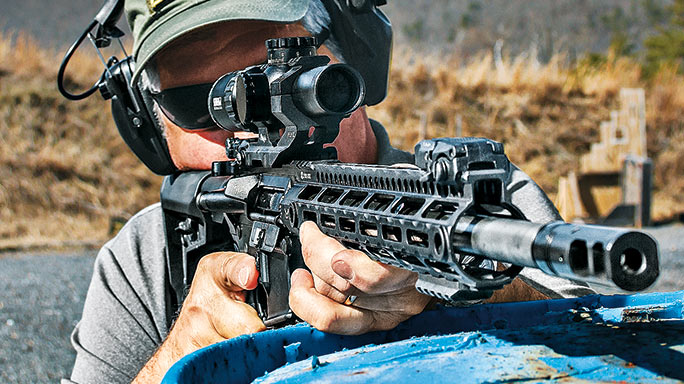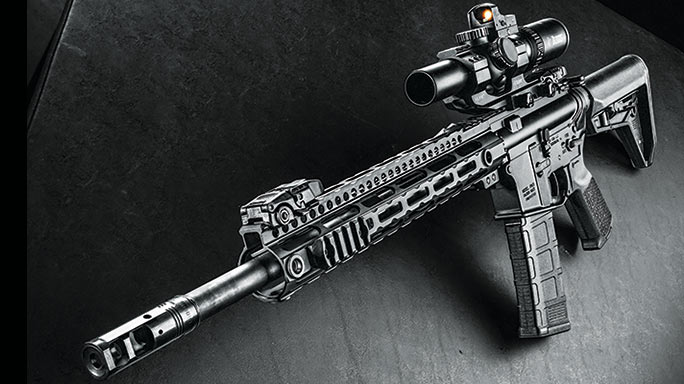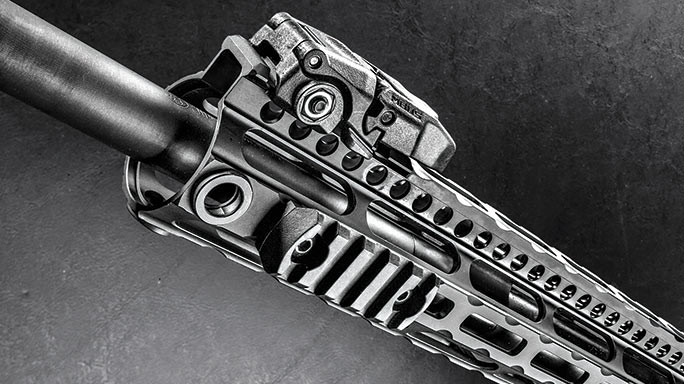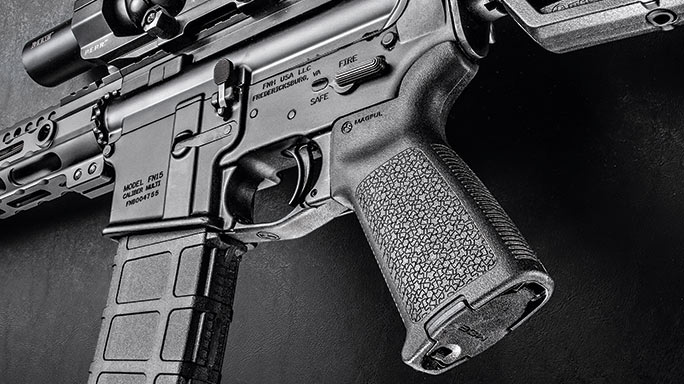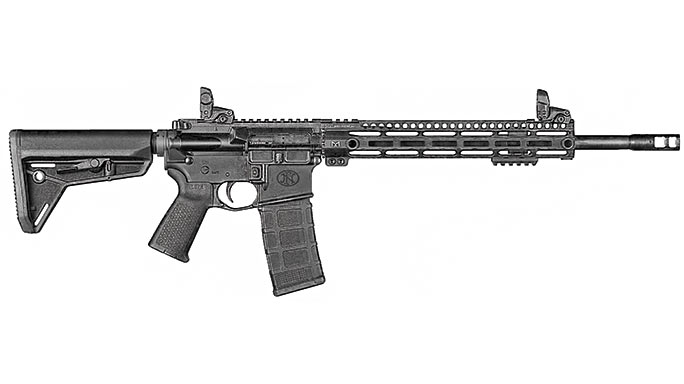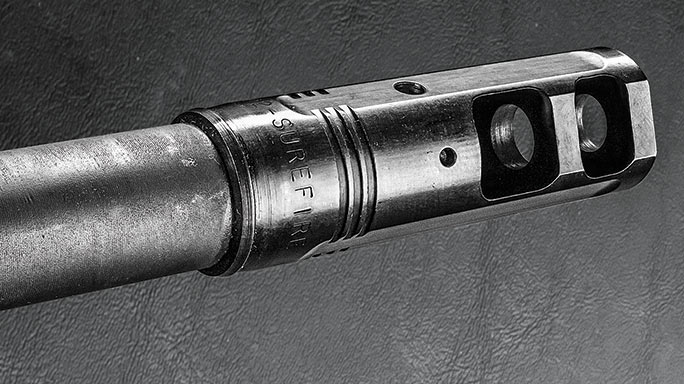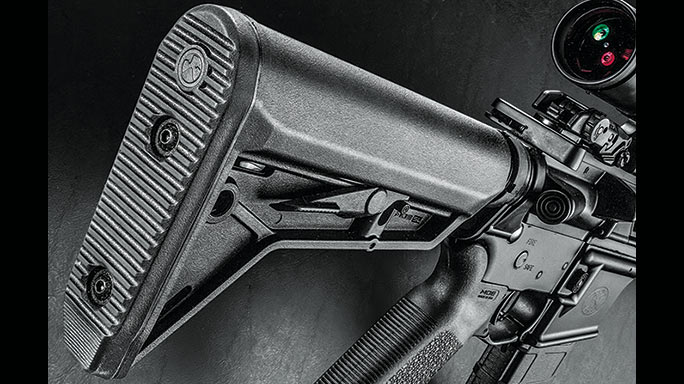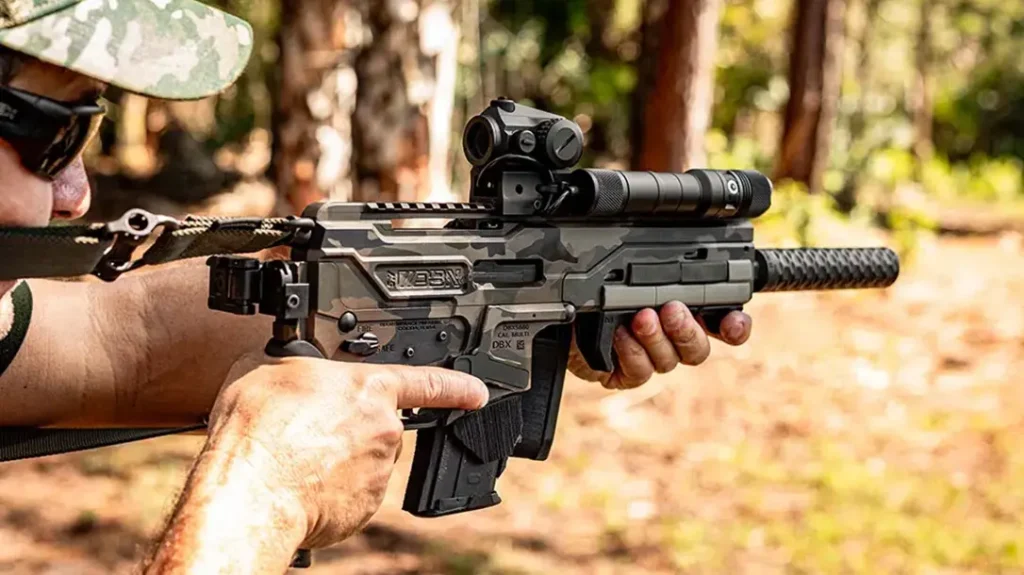Lately, much attention seems to be “improving” the AR platform via cartridge enhancement. The 300 Blackout is emerging as one of the most successful alternative AR chamberings. Reports from our ongoing war against terror have re-exposed the 5.56mm’s poor performance in putting an adversary down quickly with minimal rounds fired.
- RELATED VIDEO: FN’s Accessory-Ready FNX-45 Tactical Pistol
While the basic AR-15/M16 design is hard to improve upon when it comes to reliably launching bullets downrange accurately, many lament the 5.56mm. Though the 7.62mm NATO/ .308 AR has been around for quite some time, its increased size and weight can be drawbacks to many.
The last frontier for the AR is caliber expansion that fits within a standard 5.56mm lower receiver. Combine this with the increasing use of sound suppressors and it becomes apparent that users needed one chambering available in both supersonic and subsonic factory loadings. This is where the 300 Blackout comes into play.
Advertisement — Continue Reading Below
The 300 Blackout (7.62x35mm) was introduced by Advanced Armament Corporation (AAC) in cooperation with Remington Defense in response to the U.S. special operations community. The goal was to create a .30-caliber projectile for a standard AR platform using existing 5.56mm magazines, without reducing any magazine capacity or reliability. Another notable characteristic of the 300 Blackout is its compatibility with the standard 5.56mm AR-15 bolt, thus only a barrel change is necessary to switch calibers.
Currently, typical 115- and 125-grain 300 Blackout ammunition matches the ballistics of the AK’s 7.62x39mm and eclipses the 5.56mm in terms of ballistics and terminal punch. At 300 meters, the 300 Blackout has approximately 17-percent more energy than the 7.62x39mm. From a 9-inch barrel, the 300 Blackout has the same energy at the muzzle as the 5.56mm from a 14.5-inch-barreled M4—and surpasses it as ranges extend. One interesting twist with this cartridge is that subsonic 300 Blackout loadings are optimized to work with sound suppressors, offering even more versatility to its users.
Well, FN, a company that has made the M16/M4 series of weapons for the U.S. military for years, has decided to harness the 300 Blackout and take its vision of the AR-platform rifle another step forward with its new FN 15 Tactical.
Advertisement — Continue Reading Below
AMPED-UP Enforcer
Even though FN has been making AR-pattern rifles for decades now here in the United States, the company only recently began offering ARs to civilians as part of its FN 15 series, and the FN 15 Tactical is the latest variant to hit the market. It combines several of today’s most popular AR-platform features and enhancements with FN’s unparalleled weapons manufacturing experience.
The FN 15 Tactical’s upper and lower receivers are forged from 7075-T6 aluminum that is then hardcoat anodized. The upper receiver is a flattop design with a Picatinny rail for sights and optics. Magpul’s flip-up MBUS front and rear sights are included for the top rail. The 16-inch, match-grade, cold-hammer-forged, chrome-lined, free-floating barrel has a 1-in-7-inch twist rate and comes equipped with a SureFire ProComp 762 muzzle brake. The rifle also uses a carbine-length gas system with a low-profile gas block that weighs significantly less than standard gas blocks.
Advertisement — Continue Reading Below
Another weight-saving feature is the 12-inch Midwest Industries LWM handguard, which has M-LOK slots along the top, sides and bottom for accessories. A short top rail at the front serves as a front sight base. The lightening cuts help reduce weight and aid in barrel cooling, yet there is still plenty of room for mounting a foregrip, a bipod, lights and lasers, etc.
- RELATED STORY: SLP Competition: FN America’s 12-Gauge Range Master
The lower receiver sports standard AR controls as well as Magpul’s ergonomic, streamlined MOE SL buttstock and MOE pistol grip. The stock can be adjusted to six different length-of-pull positions, bringing the rifle from 33.7 to 37 inches in overall length. The triggerguard is also enlarged for use with gloves. All of this adds up to a rifle that weighs only 6.6 pounds unloaded, making the FN 15 Tactical one of the lighter ARs available on the market.
To test the FN 15 Tactical’s capabilities, I added a Steiner M5Xi Military 1-5x24mm scope with an illuminated reticle. The M5Xi is designed for both instinctive close-range/low-magnification situations, yet it still allows shooters to engage targets with greater precision at longer ranges thanks to its 5X magnification. With this scope attached, the FN 15 Tactical is able to handle diverse shooting scenarios—close range or distant engagements—as the mission dictates with equal aplomb. The Steiner M5Xi is ideal for AR-platform rifles, as it can serve much like a reflex sight when dialed down to 1X and using the illuminated Rapid Dot reticle, which is calibrated for the 5.56mm.
Advertisement — Continue Reading Below
Range Time
For ammunition, I chose Hornady’s supersonic 110-grain V-MAX load, Sig Sauer’s Elite Performance 125- and 220-grain Sierra MatchKing rounds, Federal American Eagle’s 220-grain subsonic OTM ammo and Black Hills’ 125-grain OTM ammo. The 220-grain loads are subsonic in nature.
My first task on the range was to record the ammunition’s velocity data. The supersonic loads clocked between 2,210 and 2,395 fps from the FN 15 Tactical’s 16-inch barrel while the subsonic 220-grain loads averaged 1,005 fps.
Advertisement — Continue Reading Below
The FN 15 Tactical’s accuracy from the bench was a pleasant surprise. Other 300 Blackout rifles I’ve tested were less than consistent—they’d favor certain loads greatly over others. But that was not the case with the FN 15 Tactical. None of the ammo tested, whether supersonic or subsonic, produced a group greater than 1.5 inches on average at 100 yards, firing three 5-round groups. This kind of accuracy justifies considering leaving a magnified optic such as the versatile Steiner M5Xi mounted on the rifle.
I spent several magazines’ worth of ammunition engaging plate racks and man-sized steel targets with the FN 15 Tactical. I quickly moved on from stand-and-deliver drills to more dynamic drills involving movement, reloads and firing from behind cover. The rifle recoiled liked a 5.56mm AR, especially with the SureFire brake installed.
Next I decided to concentrate on using the FN 15 Tactical in training scenarios involving team tactics and patrolling to contact through the Echo Valley Training Center’s 360-degree and “Jungle Walk” ranges. This allowed the FN 15 Tactical to shine in terms of potent firepower and combat accuracy. Firing from unorthodox positions while working around range vehicles showed why a lightweight AR chambered in 300 Blackout can be so effective.
Advertisement — Continue Reading Below
Interestingly, the 220-grain subsonic loads had no issue cycling the rifle, even when firing without a suppressor attached. Not every 300 Blackout rifle on the market shares this characteristic, especially if using a carbine-length gas tube in lieu of a pistol-length one. The advantage of having a 300 Blackout rifle like the FN 15 Tactical functioning with subsonic loads unsuppressed while still utilizing a carbine-length gas system is less stress on the bolt carrier and a smoother recoil impulse.
Ready For Duty
FN’s goal with the FN 15 Tactical was to create a lightweight, easy-to-operate AR rifle similar to Eugene Stoner’s original concept while incorporating some more modern approaches, including the power of the 300 Blackout. All of the FN 15 Tactical’s features are intended for maximizing your effectiveness during a fight or producing more realistic training on the range.
Advertisement — Continue Reading Below
- RELATED VIDEO: New For 2016: FN America’s Civilian-Legal M249S
Of course, the key component of a fighting rifle is reliability. No matter how accurate or powerful a rifle is, if it does not work 100 percent of the time, it is a liability. To that end, the FN 15 Tactical ran flawlessly during testing. It’s obvious that this rifle is intended for serious practitioners who plan on using it for patrolling, training or self-defense, and I cannot recommend it more highly. Make sure you check it out.
For more information, visit FNamerica.com or call 703-288-3500.
